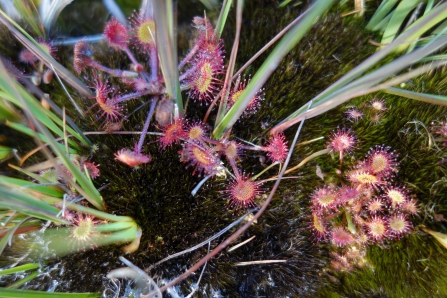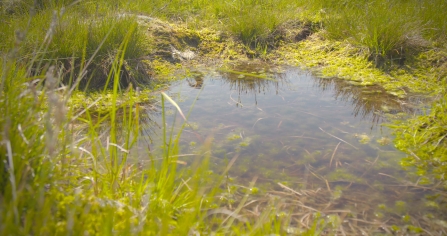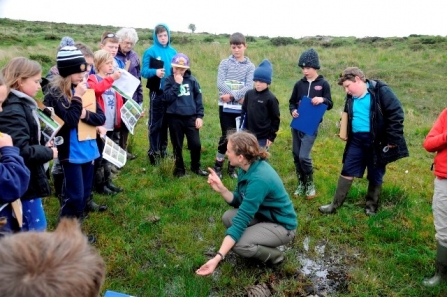
Cotton grass. Photo, Mark Hamblin
Magnificent Mires
One of Devon's least known landscapes
The Magnificent Mires project celebrated the fascinating, unrivalled natural and cultural heritage of one of Devon’s least known landscapes – the internationally important blanket bogs of Dartmoor

Bogs aren't boring
The project ran for one year and revealed the remarkable wildlife blanket bogs are home to and the vital services these areas provide.
Most visitors to Dartmoor are attracted by the tors and torrent streams, but what lies at the heart of the moors is a little known world of remarkable plants and rare wildlife.
Carnivorous sundews and butterworts lurk amongst the blanket bogs, trapping unsuspecting insects; wading birds come here to breed including the world's most southerly population of breeding dunlin; and sponge-like sphagnum mosses in shades of green, gold and red create a bouncing blanket across the land.

Photo, Jo Metcalf - Global Focus
Blanket bogs also help us
Blanket bogs are located at the headwaters of many of Devon’s larger rivers including the Dart, Tavy, Taw, and Teign. The sphagnum moss which makes up the bog has amazing absorption properties. In times of heavy rainfall, the moss soaks up water and then delivers clean, naturally filtered supplies in times of drought.
Peatlands are also a vital carbon store; Dartmoor alone stores an estimated 10 million tonnes of carbon in its peatland soils which is equivalent to an entire year of carbon dioxide emissions from UK industry.
In these ways, blanket bogs perform important functions which are crucial to our daily lives.
Pickled history
Bogs are a waterlogged environment creating a kind of archaeological pickling jar for anything that falls into it. Dartmoor supports one of the largest concentration of archaeological remains in Europe, from the Neolithic to early industrial periods. Blanket bogs have preserved some of the finest Neolithic remains found to date.
To read the story of Whitehorse Hill and the first excavation of a burial site on Dartmoor for 100 years, visit the Dartmoor National Park website.

A habitat under threat
In the past, activities such as peat cutting, over-grazing and burning, military usage and recreation have caused damage and erosion. As the habitat degrades, the ability of the bogs to deliver the services vital for local communities declines. Reduced biodiversity, poor water quality, carbon release and the loss of important historic records which span millennia are all a result of bogs drying out and eroding.
The good news is that today’s farming and landowning custodians are working hard to manage the blanket bogs for people and for wildlife.
Work carried out by Dartmoor National Park Authority has already started to restore areas of blanket bog, for more information click here.

Project highlights
Princetown bog garden
A bog garden has been created in the DPA Conservation Garden in the National Park Visitor Centre, Princetown. Carnivorous plants and sphagnum mosses take centre stage with etched sweet chestnut rails surrounding the garden. Visit the centre to see this mini-mire and learn about the plants that live on Dartmoor’s blanket bogs.
Events
The Magnificent Mires project delivered 26 community events, walks and talks giving 2210 attendees an insight into the blanket bogs of Dartmoor and the essential functions they perform.
Bog bimbles
Follow our bog walks to discover Dartmoor's bogs and mires.

School engagement
A total of 1125 children from 33 schools participated in the project. In-school sessions and fieldtrips linked to the curriculum, with a focus on Sphagnum moss, the wildlife of mires, their importance in the water and carbon cycles as well as their cultural history.
Three residential trips were delivered with support from Runnage Farm. The children explored a valley mire and the stream that flows from it, and learnt how farmers use the blanket bog for grazing livestock.
The Magnificent Mires project was led by Devon Wildlife Trust in partnership with Dartmoor National Park Authority, Dartmoor Preservation Association and The Duchy of Cornwall. The project was supported by the National Lottery through the National Lottery Heritage Fund.

